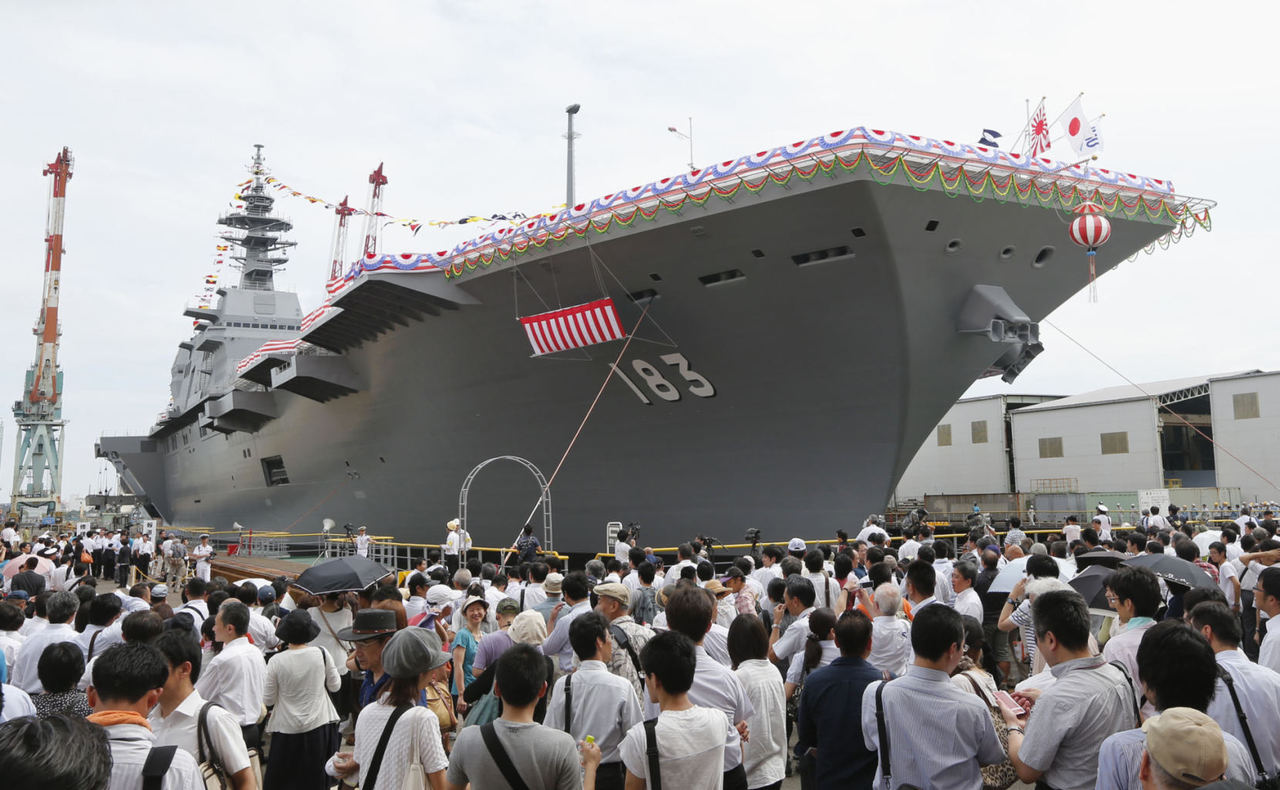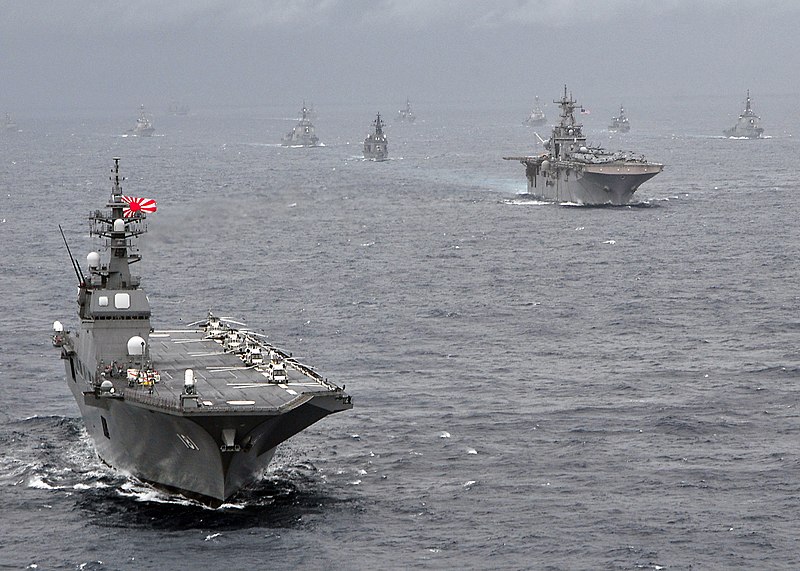Misson of JMSDF
Japan is an island country surrounded on all sides by the sea. That means any threats to our country will always approach us via the sea. In addition, Japan lacks natural resources, so it must rely on countries overseas for most of the materials that we require in our daily lives. We use a maritime transport network stretching around the globe to obtain more than 90% of these materials. In recognition of new security environment, the Defense Program Guidelines defines the role of the defense forces as “effective response to the new threats and diverse situations,” “Proactive efforts to improve the international security environment,” and “preparation for full-scale invasion,” which is the primary role of defense forces, and Japan will efficiently maintain the necessary Maritime Self-Defense Forces posture to effectively carry out missions in each the areas.
Exacerbated and tangible International Security Environment
security issues beyond a geographically-limited area continue to be crucial because the risk is growing that a disorder or a security problem in a single country spreads worldwide. With regard to such global security issues, while the international community is undertaking initiatives to deal with cyber attacks, proliferation of weapons of mass destruction and their means of delivery, international terrorism, and the increasing vulnerability of governance systems, some problems are being exacerbated and new problems are also becoming tangible.
Under such a security environment, it has become extremely diffi cult for one country to deal with issues which the international community is confronting, and ensuring regional and global peace, stability and prosperity through the establishment of a more stable international security environment benefi ts each country. It is increasingly important for countries with common interests in the resolution of issues to work together.
Security Environment in the Asia-Pacific Region
In the Asia-Pacific region, alongside the various changes that have taken place in tandem with the increase in power of China, India, and Russia, countries in the region have made efforts to enhance and strengthen intra-regional coordination and collaboration with a particular focus on non-traditional security sectors such as humanitarian aid and disaster relief, and counterpiracy measures. On the other hand, this region abounds in political, economic, ethnic, and religious diversity, confl icts between countries/regions remain even after the end of the Cold War, and their views on security and threats are different. Accordingly, major changes in the security environment have yet to emerge even after the end of the Cold War, unlike in Europe, and long-standing issues of territorial rights and reunification continue to plague the region.
Outline of The Japan-U.S. Security Arrangements

Based on the Japan–U.S. Security Treaty, the Japan-U.S. Security Arrangements constitute one of the pillars of Japan’s national defense. The Japan–U.S. Alliance, having the Japan-U.S. Security Arrangements as its core, is indispensable to maintain not only the peace and security of Japan, but also that of the entire Asia-Pacifi c region. In addition, the close cooperative relationship between Japan and the United States based on the alliance is proving to be extremely significant for effectively dealing with global security issues. Furthermore, the Japan–U.S. Alliance is playing an increasingly important role in promoting the shared fundamental values in the international community such as democracy, the rule of law, respect for human rights, and a capitalist economy.
The military presence of the U.S. forces in Japan not only contributes to the defense of Japan, but also functions as deterrence against and response to contingencies in the Asia-Pacific region, and serves as a core element of the Japan-U.S. Security Arrangements. On the other hand, since the stationing of U.S. forces in Japan impacts upon the living environment of local residents, efforts that correspond to the actual situation of each region must be made to reduce the burden on regions such as Okinawa.
Japan-U.S. Bilateral Training and Exercises
The SDF and the U.S. forces have been conducting various bilateral training and exercises in peacetime to strengthen Japan- U.S. joint response capabilities while improving interoperability and facilitating mutual understanding in regard to tactical aspects, etc. and closer communication. Since FY1985, mostly on an annual basis, command post exercise and fi eld training exercise have alternated as the Japan–U.S. Bilateral Joint Training Exercise; the fi eld training exercise held in November 2012 was the 11th of its kind. In addition, the GSDF, MSDF and ASDF are expanding the scope of joint exercises, by such means as dispatching units not only to areas within Japan, but also to the U.S., such as participation in exercises including the Japan–U.S. Bilateral Regional Army command post exercises, special anti-submarine exercises, and Japan–U.S. Bilateral Fighter combat training. Thus, continuous efforts are being made to improve interoperability and bilateral response capabilities at the military service and unit levels. As part of the efforts, Stryker Battalion, with its high maneuvering and deployment capabilities and equipped with wheeled armored personnel carrier Stryker, participated for the fi rst time in fi eld training jointly held with the U.S. army and GSDF in Japan from October to November 2012. GSDF troops participating in the exercise trained in coordination procedures with the battalion. Such joint training and exercises in peacetime not only greatly contribute to maintaining and enhancing the Japan-U.S. joint response capabilities by deepening mutual understanding of capabilities and tactics, but also are effective for improving tactical skills on each side. In particular, the knowledge and techniques that the Japanese side can learn from U.S. forces, which have vast experience in actual fi ghting, are invaluable and greatly contribute to improving the JSDF’s capabilities. In addition, holding bilateral exercises at effective times, places, and scales demonstrates the unifi ed commitment and capabilities of Japan and the United States, which has a deterrent effect. In light of these perspectives, the MOD and the SDF are continuing their efforts to enrich the contents of bilateral training and exercises.
Japan is an island country surrounded on all sides by the sea. That means any threats to our country will always approach us via the sea. In addition, Japan lacks natural resources, so it must rely on countries overseas for most of the materials that we require in our daily lives. We use a maritime transport network stretching around the globe to obtain more than 90% of these materials. In recognition of new security environment, the Defense Program Guidelines defines the role of the defense forces as “effective response to the new threats and diverse situations,” “Proactive efforts to improve the international security environment,” and “preparation for full-scale invasion,” which is the primary role of defense forces, and Japan will efficiently maintain the necessary Maritime Self-Defense Forces posture to effectively carry out missions in each the areas.
Exacerbated and tangible International Security Environment
security issues beyond a geographically-limited area continue to be crucial because the risk is growing that a disorder or a security problem in a single country spreads worldwide. With regard to such global security issues, while the international community is undertaking initiatives to deal with cyber attacks, proliferation of weapons of mass destruction and their means of delivery, international terrorism, and the increasing vulnerability of governance systems, some problems are being exacerbated and new problems are also becoming tangible.
Under such a security environment, it has become extremely diffi cult for one country to deal with issues which the international community is confronting, and ensuring regional and global peace, stability and prosperity through the establishment of a more stable international security environment benefi ts each country. It is increasingly important for countries with common interests in the resolution of issues to work together.
Security Environment in the Asia-Pacific Region
In the Asia-Pacific region, alongside the various changes that have taken place in tandem with the increase in power of China, India, and Russia, countries in the region have made efforts to enhance and strengthen intra-regional coordination and collaboration with a particular focus on non-traditional security sectors such as humanitarian aid and disaster relief, and counterpiracy measures. On the other hand, this region abounds in political, economic, ethnic, and religious diversity, confl icts between countries/regions remain even after the end of the Cold War, and their views on security and threats are different. Accordingly, major changes in the security environment have yet to emerge even after the end of the Cold War, unlike in Europe, and long-standing issues of territorial rights and reunification continue to plague the region.
Outline of The Japan-U.S. Security Arrangements

Based on the Japan–U.S. Security Treaty, the Japan-U.S. Security Arrangements constitute one of the pillars of Japan’s national defense. The Japan–U.S. Alliance, having the Japan-U.S. Security Arrangements as its core, is indispensable to maintain not only the peace and security of Japan, but also that of the entire Asia-Pacifi c region. In addition, the close cooperative relationship between Japan and the United States based on the alliance is proving to be extremely significant for effectively dealing with global security issues. Furthermore, the Japan–U.S. Alliance is playing an increasingly important role in promoting the shared fundamental values in the international community such as democracy, the rule of law, respect for human rights, and a capitalist economy.
The military presence of the U.S. forces in Japan not only contributes to the defense of Japan, but also functions as deterrence against and response to contingencies in the Asia-Pacific region, and serves as a core element of the Japan-U.S. Security Arrangements. On the other hand, since the stationing of U.S. forces in Japan impacts upon the living environment of local residents, efforts that correspond to the actual situation of each region must be made to reduce the burden on regions such as Okinawa.
Japan-U.S. Bilateral Training and Exercises
The SDF and the U.S. forces have been conducting various bilateral training and exercises in peacetime to strengthen Japan- U.S. joint response capabilities while improving interoperability and facilitating mutual understanding in regard to tactical aspects, etc. and closer communication. Since FY1985, mostly on an annual basis, command post exercise and fi eld training exercise have alternated as the Japan–U.S. Bilateral Joint Training Exercise; the fi eld training exercise held in November 2012 was the 11th of its kind. In addition, the GSDF, MSDF and ASDF are expanding the scope of joint exercises, by such means as dispatching units not only to areas within Japan, but also to the U.S., such as participation in exercises including the Japan–U.S. Bilateral Regional Army command post exercises, special anti-submarine exercises, and Japan–U.S. Bilateral Fighter combat training. Thus, continuous efforts are being made to improve interoperability and bilateral response capabilities at the military service and unit levels. As part of the efforts, Stryker Battalion, with its high maneuvering and deployment capabilities and equipped with wheeled armored personnel carrier Stryker, participated for the fi rst time in fi eld training jointly held with the U.S. army and GSDF in Japan from October to November 2012. GSDF troops participating in the exercise trained in coordination procedures with the battalion. Such joint training and exercises in peacetime not only greatly contribute to maintaining and enhancing the Japan-U.S. joint response capabilities by deepening mutual understanding of capabilities and tactics, but also are effective for improving tactical skills on each side. In particular, the knowledge and techniques that the Japanese side can learn from U.S. forces, which have vast experience in actual fi ghting, are invaluable and greatly contribute to improving the JSDF’s capabilities. In addition, holding bilateral exercises at effective times, places, and scales demonstrates the unifi ed commitment and capabilities of Japan and the United States, which has a deterrent effect. In light of these perspectives, the MOD and the SDF are continuing their efforts to enrich the contents of bilateral training and exercises.

















